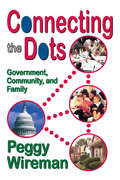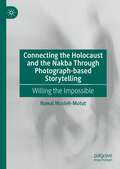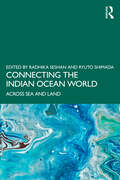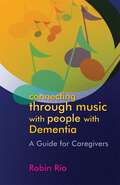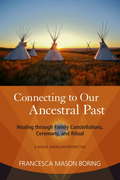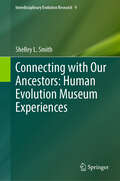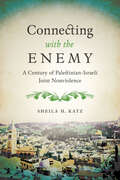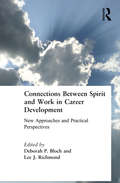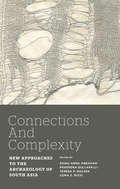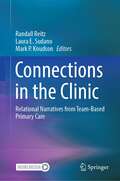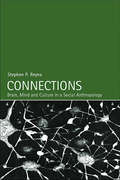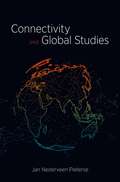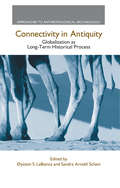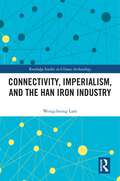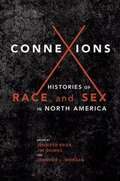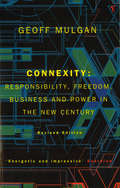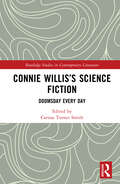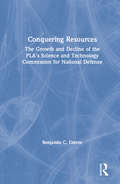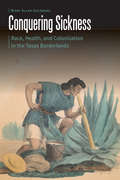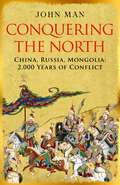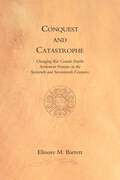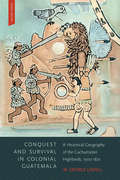- Table View
- List View
Connecting the Dots: Government, Community, and Family
by Peggy WiremanDespite its size and social diversity, the United States is one nation, and what happens in one city or neighborhood ultimately affects all Americans. "Connecting the Dots" addresses the complex relationships between family and community, and between community and other players affecting family and community life, including the private sector, government, nonprofit groups, and religious organizations. Contrary to much rhetoric, Wireman argues that America does not suffer from a loss of family values, but from a shift in business practices and public commitments. The American dream of work hard, buy a home, and give your children a better life is no longer realistic for millions of workers, both white-collar and blue-collar. At an individual level, millions of Americans face significant challenges as they go about trying to meet the everyday responsibilities of earning an income, feeding their families, maintaining their health, finding housing, handling everyday household chores, and caring for their children. Besides identifying top-down structures, laws, and attitudes that create a supportive context for family life, the book includes bottom-up anecdotal examples to ground its policy-oriented discussion. It also provides statistical data needed to develop realistic solutions. Wireman examines diversity as well, since how America handles racial and ethnic differences remains crucial to its future. She discusses ways in which communities have created social capital, community cohesion, and local organizational ability. Wireman provides a framework for policymakers, local community leaders, and neighborhood activists to use in analyzing their situations and selecting the best approach; she also describes what various players can and must do to uphold the American dream. "Connecting the Dots" will be of keen interest to sociologists, political scientists, economists, and social workers.
Connecting the Holocaust and the Nakba Through Photograph-based Storytelling: Willing the Impossible
by Nawal Musleh-MotutThis unprecedented ethnographic study introduces a unique photography-based storytelling method that brings together everyday Palestinians and Israelis to begin connecting rather than comparing their distinct yet organically connected histories of suffering and exile resulting from the Holocaust and the Nakba. Working with Palestinians and Israelis living in their respective Canadian diasporas who are of the Holocaust and Nakba postmemory generations–those who did not experience these traumas but are nonetheless haunted by them–this study demonstrates that storytelling and photography enable the occasions and conditions of possibility necessary for willing the impossible. That is, by narrating and then exchanging their (post)memories of the Holocaust and/or the Nakba through associated vernacular photographs, project participants were able to connect rather than compare their histories of suffering and exile; take moral, ethical, and political responsibility for one another; and imagine new forms of cohabitation grounded in justice and equitable rights for all.
Connecting the Indian Ocean World: Across Sea and Land
by Radhika Seshan Ryuto ShimadaThe Indian Ocean world has a rich history of socio-economic and cultural exchanges across time and space. This book and its companion, Merchants and Ports in the Indian Ocean World, explore these connections around the wider Indian Ocean world. The book examines the many overlapping linkages that existed from the early modern period and into the colonial era. It offers a clear understanding of the economic networks that extended across the Indian Ocean and the Atlantic during the 19th century. With a critical historical lens, the volume discusses themes like the opium trade in the Malay-Indonesian Archipelago – the biggest opium trade market at the time; the Safavid mission to Siam; and the economic relationship between Pondicherry and West Africa, via France. Rich in archival material, this book will be of interest for scholars and researchers of Indian Ocean history, maritime history, Indian history, economic and commercial history, South Asian history, and social history, anthropology, and trade relations in general.
Connecting the Nineteenth-Century World
by Roland WenzlhuemerBy the end of the nineteenth century the global telegraph network had connected all continents and brought distant people into direct communication 'at the speed of thought' for the first time. Roland Wenzlhuemer here examines the links between the development of the telegraph and the paths of globalization, and the ways in which global spaces were transformed by this technological advance. His groundbreaking approach combines cultural studies with social science methodology, including evidence based on historical GIS mapping, to shed new light on both the structural conditions of the global telegraph network and the historical agency of its users. The book reveals what it meant for people to be telegraphically connected or unconnected, how people engaged with the technology, how the use of telegraphy affected communication itself and, ultimately, whether faster communication alone can explain the central role that telegraphy occupied in nineteenth-century globalization.
Connecting through Music with People with Dementia: A Guide for Caregivers
by Robin RioFor people with dementia, the world can become a lonely and isolated place. Music has long been a vital instrument in transcending cognitive issues; bringing people together, and allowing a person to live in the moment. Connecting through Music with People with Dementia explains how a caregiver can learn to use melody or rhythm to connect with someone who may be otherwise non-responsive, and how memories can be stimulated by music that resonates with a part of someone's past. This user-friendly book demonstrates how even simple sounds and movements can engage people with dementia, promoting relaxation and enjoyment. All that's needed to succeed is a love of music, and a desire to gain greater communication and more meaningful interaction with people with dementia. The book provides practical advice on using music with people with dementia, and includes a songbook suggesting a range of popular song choices and a chapter focusing on the importance of caregivers looking after themselves as well as the people they care for. Suitable for both family and professional caregivers with no former experience of music therapy, and for music therapy students and entry level professionals, this accessible book will lay bare the secrets of music therapy to all.
Connecting to Our Ancestral Past
by Francesca Mason BoringConnecting to Our Ancestral Past is a pragmatic, spiritual journey that introduces a variety of specific rituals and conversations in connection with Constellations work, an experiential process that explores one's history and powerful events of the past in order to understand and resolve problems of the present. Constellations facilitator and author Francesca Mason Boring presents this therapeutic method in the context of cultures like the Shoshone, of which she is a member, that have seen the world through a prism of interrelationships for millennia. In Constellations work there is an organic quality that requires a discipline of non-judgment, one that is embraced in traditional native circles, where the whole truth of a person's life, roots, and trans-generational trauma or challenge is understood and included. Mason Boring provides a transformational walk through the universal indigenous field-- that place of healing and knowledge used by Native healers and teachers for centuries--by describing stories and rituals designed to help people with their particular struggles. These rituals, such as "Facing the Good Men"--designed to help women who have suffered abuse in relationships with men--reject Western notions of over-the-counter medication. Instead, they stress a comfortable environment whereby the "client," with the help of a facilitator, interacts with people chosen to represent concepts, things, and other people. In Western culture the word "medicine" is thought of as a concrete object, but Mason Boring explains that indigenous cultures favor a process of healing as opposed to an itemized substance. She re-opens doors that have been closed due to the exclusion of indigenous technology in the development of many Western healing traditions and introduces new concepts to the lexicon of Western psychology. A range of voices from around the world--leaders in the fields of systems constellations, theoretical physics, and tribal traditions--contribute to this exploration of aboriginal perspectives that will benefit facilitators of Constellations work, therapists, and human beings who are trying to walk with open eyes and hearts.
Connecting with Our Ancestors: Human Evolution Museum Experiences (Interdisciplinary Evolution Research #9)
by Shelley L. SmithThis book combines documentation and analysis of the contents of exhibits in 12 museums (Part 1) with interviews with experts involved in the creation of exhibits (Part 2) to explore variation in human evolution exhibits. To be successful, museum exhibits must make a personal connection with visitors, inspiring them to learn more. Human evolution exhibits thus need contemporary relevance. It is crucial to find ways to bind our deep past to our lives today. Presenting our story, and our collective history, some human evolution exhibits reach an audience of millions each year. An understanding of evolution is fundamental to modern biology, and a lack of knowledge of basic principles has practical consequences, including impairing reception of health messages. The goal of the volume is to stimulate discussion of how the presentation of evolution, and in particular human evolution, can be improved, contributing to scientific literacy and engagement with evolutionary science. To enhance relevance to a broader public, the author argues that incorporation of evolutionary medicine and clearer explanations of ancestry and human biological variation are needed. The surveyed museums include four in Texas, the author’s home state, seven additional renowned U.S. museums, and the Natural History Museum in London. Some of the 35 interviewees are prominent academic researchers; other contribute their expertise in design, art, and education. Topics discussed include exhibit content and changing exhibits, the ideal vs. reality in exhibit creation, self-assessments of exhibits, education and “edutainment,” and exhibit content intersections with religion, politics, and the history of representations of race / human biological variation. A bibliographic essay, appendices, and text boxes provide additional information for readers desiring more in-depth study. This volume is of interest to a wide range of readers in anthropology, museum studies, and science communication.
Connecting with the Enemy: A Century of Palestinian-Israeli Joint Nonviolence
by Sheila H. Katz&“Highlights the significance of those Israelis and Palestinians who have chosen connection and dialogue as a practical alternative to the use of force.&” —Euphrates Institute Thousands of ordinary people in Israel and Palestine have engaged in a dazzling array of daring and visionary joint nonviolent initiatives for more than a century. They have endured despite condemnation by their own societies, repetitive failures of diplomacy, harsh inequalities, and endemic cycles of violence. Connecting with the Enemy presents the first comprehensive history of unprecedented grassroots efforts to forge nonviolent alternatives to the lethal collision of the two national movements. Bringing to light the work of over five hundred groups, Sheila H. Katz describes how Arabs and Jews, children and elders, artists and activists, educators and students, garage mechanics and physicists, and lawyers and prisoners have spoken truth to power, protected the environment, demonstrated peacefully, mourned together, stood in resistance and solidarity, and advocated for justice and security. She also critiques and assesses the significance of their work and explores why these good-will efforts have not yet managed to end the conflict or occupation. This previously untold story of Palestinian-Israeli joint nonviolence will challenge the mainstream narratives of terror and despair, monsters and heroes, that help to perpetuate the conflict. It will also inspire and encourage anyone grappling with social change, peace and war, oppression and inequality, and grassroots activism anywhere in the world. &“A profoundly important study of the history and ongoing efforts for Israeli-Palestinian peace by ordinary Israelis and Palestinians . . . A genuinely balanced perspective.&” —Stephen Zunes, author of Tinderbox: U.S. Middle East Policy and the Roots of Terrorism
Connections Between Spirit and Work in Career Development: New Approaches and Practical Perspectives
by Deborah P Bloch Lee RichmondIn an age of organizational restructuring and career uncertainty, with upward mobility becoming less and less attainable, how do people find meaning and fulfilment in their work? This book addresses this critical question, offering valuable, concrete suggestions to career development professionals working with clients who long to infuse their work with values. Featuring the insights of leading counsellors and career development practitioners, educators, psychologists, clergy, and management experts, the eleven chapters in Connections Between Spirit and Work in Career Development explain how money, age, gender, and spirituality affect job satisfaction. The authors examine changes that enhance the sense of wholeness in a career, offering illuminating examples showing how people have achieved the goal of balancing work, family life, relationships, and spiritual practice. Responding to the rapidly changing terrain of contemporary work life, this volume presents an extraordinary range of tools and options for career development professionals in their work with their clients.
Connections and Complexity: New Approaches to the Archaeology of South Asia
by Shinu Anna Abraham Praveena Gullapalli Teresa P. Raczek Uzma Z. RizviThis compilation of original research articles highlight the important cross-regional, cross-chronological, and comparative approaches to political and economic landscapes in ancient South Asia and its neighbors. Focusing on the Indus Valley period and Iron Age India, this volume incorporates new research in South Asia within the broader universe of archaeological scholarship. Contributions focus on four major themes: reinterpreting material culture; identifying domains and regional boundaries; articulating complexity; and modeling interregional interaction. These studies develop theoretical models that may be applicable researchers studying cultural complexity elsewhere in the world.
Connections in the Clinic: Relational Narratives from Team-Based Primary Care
by Randall Reitz Laura E. Sudano Mark P. KnudsonThis book assembles many of the foremost writers and clinicians in the field of team-based primary care to share their own relational reflections. It features narratives from fields such as integrated behavioral health, integrated primary care, primary care behavioral health, medical family therapy, health psychology, primary care psychology, and clinical social work. The key focus of the chapters are the relationships that are formed during primary care delivery. The book is organized into six core chapters: Family of Origin, Teachers and Mentors, Our Patients and Ourselves, Colleagues and Collaborators, Clinician as Patient, and Death and Loss. Each chapter contains a variety of styles and formats of narrative medicine, including personal reflections, story-telling, and poetry. Connections in the Clinic will be of interest to a wide audience of clinicians and educators dedicated to a reflective or story-telling approach to healing.
Connections: Basic Skills in Social Studies
by Steck-VaughnA second chance for your low-level readers having trouble in the content areas. Connections offers subject-specific titles in all the content areas written at reading levels 5-8. Designed for independent use. Connections is truly a self-directed program. With its low reading level and straightforward directions, students can measure their own progress with pre-tests and post-tests. Correlation charts are tied to test questions directing them to the precise pages to study for each type of question. <BR>-- Units on the world of work and careers are tied to content areas. Answers and explanations in each book enable students to check their answers and understand the thinking behind each question. Real-life and work graphics content designed for secondary students help them connect academic skills with life and work skills. Reading selections emphasize comprehension, so students can improve reading skills as they gain content knowledge.
Connections: Brain, Mind and Culture in a Social Anthropology
by Stephen P. ReynaHave you ever wondered how the internal space of our brain connects with the external space of society? Drawing on hermeneutics and neuroscience Stephen Reyna develops an anthropological theory that explains the relationship between the biological and the cultural.Recent popular interest in the brain is evident, and now social anthropologists are starting to consider connections between science and anthropology. Reyna is an anthropologist prepared to tackle big and difficult questions. This accessibly written book will cause quite a stir in anthropology, and will appeal to those interested in the mysteries of the brain.
Connectivity and Global Studies
by Jan Nederveen PieterseThis textbook provides readers with evocative and analytical accounts of social processes that are linked to globalization and connectivity, which includes a wide range of multi-centred connections in history, DNA analysis, technology, art, populism and political economy. Rather than globalization, Nederveen Pieterse focuses on connectivity. His approach to globalization differs from both structuralist accounts of the world-system, and the institutionally-centred focus of much work in international studies. This synthesis will provide a new resource to reconstruct theoretical approaches to globalization and global studies. Fluently written, clearly organized and with an interdisciplinary approach, the book will be accessible to upper division undergraduates and graduates in social sciences, including students and researchers from the fields of sociology, politics, political economy, development studies and international relations.
Connectivity in Antiquity: Globalization as a Long-Term Historical Process
by Oystein S. LaBianca Sandra Arnold SchamToday's politicians argue that the more 'connected' societies are the less danger they pose to global stability. But is this a 'new' idea or one as old as history itself? Trade routes as far back as prehistory were responsible for the exchange of ideas as well as goods, leading to the rapid expansion of states and empires. 'Connectivity in Antiquity' brings together a team of influential scholars to examine the process of globalization in antiquity. The essays examine metallurgy, social evolution, economic growth and the impact of religious pilgrimage, and range across the eastern Mediterranean, Syria, the Transjordan, south Yemen, and Egypt. 'Connectivity in Antiquity' will be of value to all those interested in the relationship between antiquity and modern globalisation.
Connectivity, Imperialism, and the Han Iron Industry (Routledge Studies in Chinese Archaeology)
by Wengcheong LamThis book examines the rise of the iron industry during the Warring States and Western Han periods (ca. 400 BCE–9 CE) in ancient China, which is characterized not only by various technological innovations but also as a remarkable phenomenon, leading to the widespread distribution of iron implements and the emergence of massive ironworks that were rarely seen in later periods. With Connectivity, Imperialism, and the Han Iron Industry, Lam Wengcheong combines archaeological and historical analyses to piece together fragmentary evidence and to refocus our gaze onto the economic and political mechanism that gave birth to an iron industry unique in the ancient world. Guiding readers through the macroscopic social settings of the iron industry and distribution patterns of iron implements to the microscopic organization of workplace and workers’ foodways, Lam explores how iron production and transportation processes intersected with the transformation of the Han capital region in the Guanzhong basin. Using various lines of evidence of iron production in Guanzhong and its connection with other production centers, this book shows how the production and transportation of iron at various scales played a significant role in generating the "connectivity" between various parts of the Western Han empire, and casts new light on the workings of the economic system in imperial China. Connectivity, Imperialism, and the Han Iron Industry will appeal to anyone interested in Chinese archaeology, the history of the Han empire, and the history of science and engineering in ancient China, as well as to scholars working on the comparative study of ancient imperialism, market exchange, and economic history.
Connexions: Histories of Race and Sex in North America
by Jennifer Brier Jim Downs Jennifer L MorganConnexions investigates the ways in which race and sex intersect, overlap, and inform each other in United States history. An expert team of editors curates thought-provoking articles that explore how to view the American past through the lens of race and sexuality studies. Chapters range from the prerevolutionary era to today to grapple with an array of captivating issues: how descriptions of bodies shaped colonial Americans' understandings of race and sex; same-sex sexual desire and violence within slavery; whiteness in gay and lesbian history; college women's agitation against heterosexual norms in the 1940s and 1950s; the ways society used sexualized bodies to sculpt ideas of race and racial beauty; how Mexican silent film icon Ramon Navarro masked his homosexuality with his racial identity; and sexual representation in mid-twentieth-century black print pop culture. The result is both an enlightening foray into ignored areas and an elucidation of new perspectives that challenge us to reevaluate what we "know" of our own history. Contributors: Sharon Block, Susan K. Cahn, Stephanie M. H. Camp, J. B. Carter, Ernesto Chávez, Brian Connolly, Jim Downs, Marisa J. Fuentes, Leisa D. Meyer, Wanda S. Pillow, Marc Stein, and Deborah Gray White.
Connexity: How to Live in a Connected World
by Geoff MulganCONNEXITY is the philosophical counterpart to Will Hutton's essentially political book. It looks at the profound tension that exists between two recent achievements of humanity: greater freedom (over how to live, who to love, what to believe and say, where to trade), and greater interdependence, or 'connexity' (through the financial markets, military structures, the internet, the ecosystem). This tension has led to crisis: institutions, including governments, sense themselves to be inadequate; individuals are faced with a mass of conflicting information and values. The issue we face, which will ultimately determine human survival in our densely packed planet, is how the tension between these two can be resolved, and a new order established. Mulgan presents his own powerful solution to this crisis. It is based around the notion of 'connexity': breaking down our rigid sense of ourselves as isolated units and seeing our lives as part of a system, a positive network of co-responsibility.
Connie Willis’s Science Fiction: Doomsday Every Day (Routledge Studies in Contemporary Literature)
by Carissa Turner SmithIn spite of Connie Willis’s numerous science fiction awards and her groundbreaking history as a woman in the field, there is a surprising dearth of critical publication surrounding her work. Taking Doomsday Book as its cue, this collection argues that Connie Willis’s most famous novel, along with the rest of her oeuvre, performs science fiction’s task of cognitive estrangement by highlighting our human inability to read the times correctly—and yet also affirming the ethical imperative to attempt to truly observe and record our temporal location. Willis’s fiction emphasizes that doomsdays happen every day, and they risk being forgotten by some, even as their trauma repeats for others. However, disasters also have the potential to upend accepted knowledge and transform the social order for the better, and this collection considers the ways that Willis pairs comic and tragic modes to reflect these uncertainties.
Conquering Heroines: How Women Fought Sex Bias at Michigan and Paved the Way for Title IX
by Sara FitzgeraldIn 1970, a group of women in Ann Arbor launched a crusade with an objective that seemed beyond reach at the time—force the University of Michigan to treat women the same as men. Sex discrimination was then rampant at U-M. The school’s admissions officials sought to maintain a ratio of 55:45 between male and female undergraduate entrants, turning away more qualified female applicants and arguing, among other things, that men needed help because they were less mature and posted lower grades. Women comprised less than seven percent of the University’s faculty members and their salaries trailed their male peers by substantial amounts. As one administrator put it when pressed about the disparity, “Men have better use for the extra money.” Galvanized by their shared experiences with sex discrimination, the Ann Arbor women organized a group called FOCUS on Equal Employment for Women, led by activist Jean Ledwith King. Working with Bernice Sandler of the Women’s Equity Action League, they developed a strategy to unleash the power of another powerful institution—the federal government—to demand change at U-M and, they hoped, across the world of higher education. Prompted by a complaint filed by FOCUS, the U.S. Department of Health, Education, and Welfare soon documented egregious examples of discrimination in Michigan’s practices toward women and threatened to withhold millions of dollars in contracts unless the school adopted remedies. Among the hundreds of similar complaints filed against U.S. colleges in 1970–1971, the one brought by the Michigan women achieved the breakthrough that provided the historic template for settlements with other institutions. Drawing on oral histories from archives as well as new interviews with living participants, Conquering Heroines chronicles this pivotal period in the histories of the University of Michigan and the women’s movement. An incredible story of grassroots activism and courageous women, the book highlights the kind of relentless effort that has helped make inclusivity an ongoing goal at U-M.
Conquering Resources: The Growth and Decline of the PLA's Science and Technology Commission for National Defense
by Benjamin C. Ostrov Richard P. SuttmeierThis case study seeks to explain how organizations grow and the limits to that growth when an organization engaged in policy implementation lacks the resources necessary to achieve policy goals. The discussion of the basis of conflict that emerges from this study is of lasting significance. For years, studies of this issue have pointed to various models of factionalism, stressing the informal character of the groups involved. In Professor Ostrov's study, however, conflict is shown to have a supra-Cultural Revolutionary institutional basis in this and other key units.
Conquering Sickness: Race, Health, and Colonization in the Texas Borderlands (Borderlands and Transcultural Studies)
by Mark Allan GoldbergPublished through the Early American Places initiative, supported by the Andrew W. Mellon Foundation.Conquering Sickness presents a comprehensive analysis of race, health, and colonization in a specific cross-cultural contact zone in the Texas borderlands between 1780 and 1861. Throughout this eighty-year period, ordinary health concerns shaped cross-cultural interactions during Spanish, Mexican, and Anglo colonization. Historians have shown us that Spanish, Mexican, and Anglo American settlers in the contested borderlands read the environment to determine how to live healthy, productive lives. Colonizers similarly outlined a culture of healthy living by observing local Native and Mexican populations. For colonists, Texas residents’ so-called immorality—evidenced by their “indolence,” “uncleanliness,” and “sexual impropriety”—made them unhealthy. In the Spanish and Anglo cases, the state made efforts to reform Indians into healthy subjects by confining them in missions or on reservations. Colonists’ views of health were taken as proof of their own racial superiority, on the one hand, and of Native and Mexican inferiority, on the other, and justified the various waves of conquest. As in other colonial settings, however, the medical story of Texas colonization reveals colonial contradictions. Mark Allan Goldberg analyzes how colonizing powers evaluated, incorporated, and discussed local remedies. Conquering Sickness reveals how health concerns influenced cross-cultural relations, negotiations, and different forms of state formation. Focusing on Texas, Goldberg examines the racialist thinking of the region in order to understand evolving concepts of health, race, and place in the nineteenth century borderlands.
Conquering the North: China, Russia, Mongolia: 2,000 Years of Conflict
by John ManA panoramic history of the roots of China and Mongolia&’s historic rivalry… and why it matters now. &‘A beguiling blend of history and intimate narrative – and a delight to read.&’ Colin Thubron, author of Shadow of the Silk Road The Great Wall of China – stretching from the arid rises of Gansu province to the cold waters of the Bohai Sea – remains an enduring symbol of Chinese might. And yet for all its grandeur, the Wall also marks a vulnerability: an ever-present reminder of old battlelines and never-ending tension with China&’s northern neighbours. Travelling by sacred mountains and along forgotten trade routes, John Man journeys through China and Mongolia, tracing the contours of their uneasy shared histories. From the tumult of the Warring States Period to the present day, Man weaves a thrilling tale of battling warlords, imperial power plays, Soviet interference and contemporary political manoeuvring. Looking to the future of the region, Conquering the North canvasses the still fractious interplay of two rival cultures and the continuing struggle for Mongolian sovereignty as China continues to edge north.
Conquest and Catastrophe: Changing Rio Grande Pueblo Settlement Patterns in the Sixteenth and Seventeenth Centuries
by Elinore M. BarrettThis book forces a rethinking of our understanding of the Pueblo Indians of New Mexico between the beginning of Spanish exploration in 1540 and the aftermath of revolt and reconquest at the end of the 1600s. Specifically, Pueblo losses of settlements and population are reinterpreted in a masterful synthesis of history, archaeology, and human geography, including discussion of the natural environment based on paleoclimate reconstructions. Barrett shows that the greatest loss of Pueblo settlements occurred in the 1630s when 51 percent of the Rio Grande pueblos were abandoned in the wake of Spanish colonization and mission building that began in 1600. Between 1600 and the revolt of 1680 the number dropped by 62 percent, from 81 to 31 pueblos.By providing the first multifaceted and holistic account of Pueblo settlements in the Rio Grande region over a period of 160 years, Barrett offers a new perspective on the dynamics of Pueblo-Spanish interactions. Spanish exploitation and disruption of the Pueblo economy, Apachean raids, and the impact of droughts are re-assessed. But a major epidemic from 1636-40 likely proved the most crucial factor in the reduction of Pueblo population and settlements. Moreover, the gradual realization of the extent of their losses and grasping what it would mean for their continued existence was probably the most important factor, more than religious or civil persecution, in galvanizing the Pueblo peoples to achieve the unprecedented unity that made possible their successful uprising in 1680. They were unable to sustain this unity when the Spanish returned in 1692 and suffered further losses of pueblos, population, and territory as a result of the reconquest.No serious future work on the Pueblos can be undertaken without reference to this one. The text, simply put, clarifies the entire framework of early Spanish-Indian relations.--Marc Simmons
Conquest and Survival in Colonial Guatemala, Fourth Edition: A Historical Geography of the Cuchumatán Highlands, 1500-1839
by W. George LovellConquest and Survival in Colonial Guatemala examines the impact of Spanish conquest and colonial rule on the Sierra de los Cuchumatanes, a frontier region of Guatemala adjoining the country’s northwestern border with Mexico. While Spaniards penetrated and left an enduring mark on the region, the vibrant Maya culture they encountered was not obliterated and, though subjected to considerable duress from the sixteenth century on, endures to this day. This fourth edition of George Lovell’s classic work incorporates new data and recent research findings and emphasizes native resistance and strategic adaptation to Spanish intrusion. Drawing on four decades of archival foraging, Lovell focuses attention on issues of land, labour, settlement, and population to unveil colonial experiences that continue to affect how Guatemala operates as a troubled modern nation. Acclaimed by scholars across the humanities and social sciences, Conquest and Survival in Colonial Guatemala remains a seminal account of the impact of Spanish colonialism in the Americas and a landmark contribution to Mesoamerican studies.
